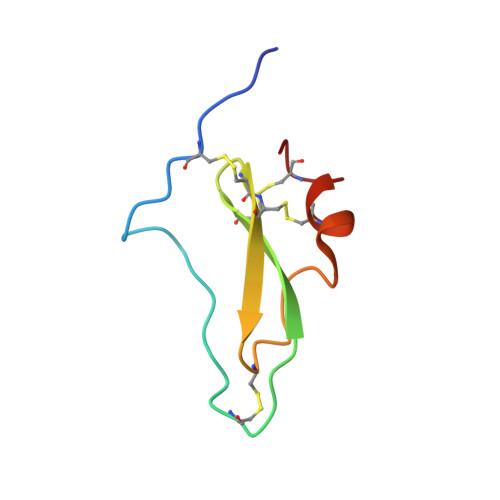Oxidative folding and structural analyses of a kunitz-related inhibitor and its disulfide intermediates: functional implications.
Bronsoms, S., Pantoja-Uceda, D., Gabrijelcic-Geiger, D., Sanglas, L., Aviles, F.X., Santoro, J., Sommerhoff, C.P., Arolas, J.L.(2011) J Mol Biol 414: 427-441
- PubMed: 22033478
- DOI: https://doi.org/10.1016/j.jmb.2011.10.018
- Primary Citation of Related Structures:
2LFK, 2LFL - PubMed Abstract:
Tick-derived protease inhibitor (TdPI) is a tight-binding Kunitz-related inhibitor of human tryptase β with a unique structure and disulfide-bond pattern. Here we analyzed its oxidative folding and reductive unfolding by chromatographic and disulfide analyses of acid-trapped intermediates. TdPI folds through a stepwise generation of heterogeneous populations of one-disulfide, two-disulfide, and three-disulfide intermediates, with a major accumulation of the nonnative three-disulfide species IIIa. The rate-limiting step of the process is disulfide reshuffling within the three-disulfide population towards a productive intermediate that oxidizes directly into the native four-disulfide protein. TdPI unfolds through a major accumulation of the native three-disulfide species IIIb and the subsequent formation of two-disulfide and one-disulfide intermediates. NMR characterization of the acid-trapped and further isolated IIIa intermediate revealed a highly disordered conformation that is maintained by the presence of the disulfide bonds. Conversely, the NMR structure of IIIb showed a native-like conformation, with three native disulfide bonds and increased flexibility only around the two free cysteines, thus providing a molecular basis for its role as a productive intermediate. Comparison of TdPI with a shortened variant lacking the flexible prehead and posthead segments revealed that these regions do not contribute to the protein conformational stability or the inhibition of trypsin but are important for both the initial steps of the folding reaction and the inhibition of tryptase β. Taken together, the results provide insights into the mechanism of oxidative folding of Kunitz inhibitors and pave the way for the design of TdPI variants with improved properties for biomedical applications.
Organizational Affiliation:
Institut de Biotecnologia i de Biomedicina and Departament de Bioquímica i Biologia Molecular, Universitat Autònoma de Barcelona, Mòdul B Parc de Recerca, E-08193 Bellaterra, Spain.














